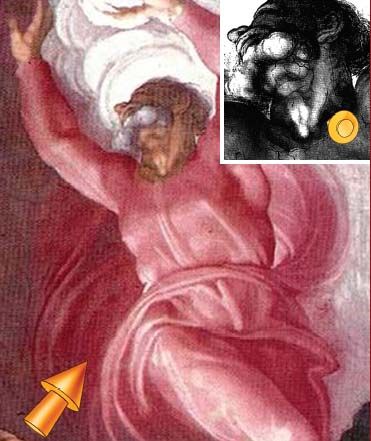Pixel's Revenge timelapse showreel from David Coiffier on Vimeo.
Sunday, May 30, 2010
Michelangelo's secret message in the Sistine Chapel: A juxtaposition of God and the human brain
"At the age of 17 he began dissecting corpses from the church graveyard. Between the years 1508 and 1512 he painted the ceiling of the Sistine Chapel in Rome. Michelangelo Buonarroti—known by his first name the world over as the singular artistic genius, sculptor and architect—was also an anatomist, a secret he concealed by destroying almost all of his anatomical sketches and notes. Now, 500 years after he drew them, his hidden anatomical illustrations have been found—painted on the ceiling of the Sistine Chapel, cleverly concealed from the eyes of Pope Julius II and countless religious worshipers, historians, and art lovers for centuries—inside the body of God."

Read the rest of the article by clicking on the title bar for Scientific American

Read the rest of the article by clicking on the title bar for Scientific American
Labels:
Michelangelo,
Sistine Chapel
Friday, May 21, 2010
Scientists in the US have succeeded in developing the first synthetic living cell
"The researchers constructed a bacterium's "genetic software" and transplanted it into a host cell.

The resulting microbe then looked and behaved like the species "dictated" by the synthetic DNA.
The advance, published in Science, has been hailed as a scientific landmark, but critics say there are dangers posed by synthetic organisms.
The researchers hope eventually to design bacterial cells that will produce medicines and fuels and even absorb greenhouse gases.
Craig Venter defends the synthetic living cell
The team was led by Dr Craig Venter of the J Craig Venter Institute (JCVI) in Maryland and California."

The resulting microbe then looked and behaved like the species "dictated" by the synthetic DNA.
The advance, published in Science, has been hailed as a scientific landmark, but critics say there are dangers posed by synthetic organisms.
The researchers hope eventually to design bacterial cells that will produce medicines and fuels and even absorb greenhouse gases.
Craig Venter defends the synthetic living cell
The team was led by Dr Craig Venter of the J Craig Venter Institute (JCVI) in Maryland and California."
Labels:
Bacteria,
Biology,
Craig Venter,
DNA,
J Craig Venter Institute,
Organism
Thursday, May 20, 2010
Friday, May 14, 2010
Spock beams down to Vulcan, Alberta, Canada
Labels:
leonard nimoy,
spock,
star trek
Tuesday, May 11, 2010
Monday, May 10, 2010
Mercury high in Japanese town that hunts dolphins
May 9, 10:11 AM (ET)
By JAY ALABASTER
TAIJI, Japan (AP) - "Residents of the dolphin-hunting village depicted in Oscar documentary "The Cove" have dangerously high mercury levels, likely because of their fondness for dolphin and whale meat, a government lab said Sunday.
The levels of mercury detected in Taiji residents were above the national average, but follow-up tests have found no ill effects, according to the National Institute for Minamata Disease. The tests were done on hair samples from 1,137 volunteers of the town's roughly 3,500 residents.
"The results suggest there is a connection between hair mercury levels and eating cetaceans," Director Koji Okamoto told reporters at town hall.
Mercury accumulates up the food chain, so large predators such as dolphins, tuna and swordfish tend to have the highest levels. The latest studies published by the Japanese government show that meat from bottlenose dolphins had about 1,000 times the mercury content of that from sardines."
Read the entire article by clicking on the title bar
By JAY ALABASTER
TAIJI, Japan (AP) - "Residents of the dolphin-hunting village depicted in Oscar documentary "The Cove" have dangerously high mercury levels, likely because of their fondness for dolphin and whale meat, a government lab said Sunday.
The levels of mercury detected in Taiji residents were above the national average, but follow-up tests have found no ill effects, according to the National Institute for Minamata Disease. The tests were done on hair samples from 1,137 volunteers of the town's roughly 3,500 residents.
"The results suggest there is a connection between hair mercury levels and eating cetaceans," Director Koji Okamoto told reporters at town hall.
Mercury accumulates up the food chain, so large predators such as dolphins, tuna and swordfish tend to have the highest levels. The latest studies published by the Japanese government show that meat from bottlenose dolphins had about 1,000 times the mercury content of that from sardines."
Read the entire article by clicking on the title bar
Saturday, May 08, 2010
Neanderthal genome reveals interbreeding with humans
 Image via Wikipedia
Image via Wikipedia
They are so closely related that some researchers group them and us as a single species. "I would see them as a form of humans that are bit more different than humans are today, but not much," says Svante Pääbo, a palaeogeneticist at the Max Planck Institute in Leipzig, Germany, whose team sequenced the Neanderthal genome."
Labels:
neanderthal,
Neanderthal genome project
Subscribe to:
Comments (Atom)
![Reblog this post [with Zemanta]](http://img.zemanta.com/reblog_e.png?x-id=216ad0d8-ae62-4789-8123-f41a69b9dd7c)

![Reblog this post [with Zemanta]](http://img.zemanta.com/reblog_e.png?x-id=32eb76ad-8c8e-4efc-ad90-3fec01233bda)
![Reblog this post [with Zemanta]](http://img.zemanta.com/reblog_e.png?x-id=5c15bfa6-9171-4cbf-b59d-3abc29348a2a)



